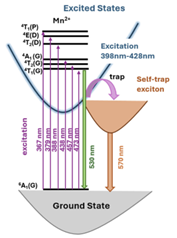Tunable Broadband Emission via Self-Trapped Excitons and Mn2+ Energy Transfer in a 0D Hybrid Manganese Bromide
Title: Tunable Broadband Emission via Self-Trapped Excitons and Mn2+ Energy Transfer in a 0D Hybrid Manganese Bromide
Authors: P. Peksa*, M. Ptak, M. Dyksik, A. Surrente, M. Baranowski, D. Drozdowski, A. Gągor, J. Osmólska, A. Kuc, A. Pikul, D. Szewczyk, P. Płochocka, A. Sieradzki*
Journal: Small
In this article, structural, phonon, optical, magnetic, and dielectric properties of novel hybrid organic-inorganic crystal of a zero-dimensional bromomethyltrimethylammonium manganese bromide, TMBM2MnBr4, are studied as an efficient green phosphor. This material undergoes two structural order-disorder phase transitions responsible for a step-like dielectric behavior and an additional one at 40 K associated with the final ordering or freezing of the cation dynamics. The detailed optical and theoretical studies demonstrated that the observed emission is governed by the interplay between exciton dynamics and cation ordering and includes not only Mn2+ d-d transitions but also the self-trapped exciton formation. The competition between self-trapped exciton and energy transfer to Mn2+ centers enables tunable emission, while variations in Mn─Br bond lengths across crystallographically distinct tetrahedra modulate crystal field strength and emission energy. The emission properties in external magnetic fields up to 65 T are also discussed. These results into structure-property relationships in low-dimensional manganese halides offer promising ways to design efficient, tunable luminescent materials.

Highlights:
- The 0D TMBM2MnBr4 crystal exhibits efficient broad green luminescence.
- The mechanism of STE emission is discussed.
- • The mechanisms of structural phase transitions are explained.
See also
- The Institute
- General information
- Employees
- News
- Scientific News
- Gender equality plan
- Address and contact data
- Research
- Research profile
- List of publications
- List of projects
- International cooperation
- Information in BIP
- Scientific Council
- Organizational structure
- GDPR


